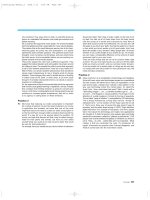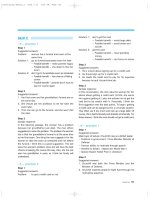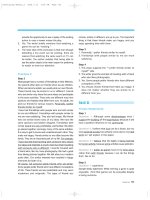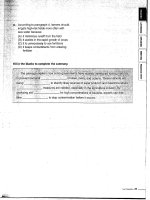Tài liệu Developing skills for the toefl ibt transcript part 5 ppt
Bạn đang xem bản rút gọn của tài liệu. Xem và tải ngay bản đầy đủ của tài liệu tại đây (65.7 KB, 10 trang )
Transcripts
695
erly combined. They argue that, to date, no scientific study has
proven an undeniable link between man-made gas emissions and
global warming.
Let us examine the arguments more closely: The environmentalists
claim that global warming is responsible for many natural disasters.
They believe that as the world becomes warmer due to the heat-
retaining gases we pump into the atmosphere, our planet
experiences severe climatic upheaval. This upheaval causes more
droughts, more hurricanes and tornadoes, and even phenomena
like tidal waves. Environmentalists believe we are pushing our
planet towards environmental disaster.
Those who oppose this view have a different argument. They
suggest that natural disasters and wild weather have been around
for millions of years. The example they offer to prove their argument
is the El Niño weather phenomenon. Have any of you heard of it?
Well, El Niño is an ancient weather phenomenon that sometimes
causes ocean temperatures to rise or tropical winds to change
direction. These changes often result in terrible storms or flooding
in certain areas of the Earth. In other areas, it can even cause
drought. It’s a totally natural phenomenon, as natural as volcanic
eruptions or earthquakes.
So, the opponents of the environmental lobby think the argument
that humans cause global warming is hypothesis, not fact. Instead,
they complain that limiting emissions is going to cost jobs and
money. Until there is indisputable proof linking greenhouse gas
emissions to increased global temperatures, they tell us, there
is no urgency in cutting down on these emissions.
Practice 3
W: We know that reducing our water consumption is important
for a variety of reasons. As we have been studying in our course
in agriculture this semester, we know that one of the most
important reasons we need to curtail our water consumption is
so that we will have enough water to produce food around the
world. It is easy for us to be worried about this problem. Of
course, we hope that farmers will find a way to obtain enough
water for their plants and animals, but have you ever asked
yourself what you could do to help conserve water that could
be used for food production?
For example, have you noticed that you have a kitchen or bathroom
faucet that drips? Each drop of water might not be that much
by itself, but add up all of those drops from the leaky faucet
over the course of a month and it amounts to many liters of
water that could be used more effectively. You can also turn off
the water as you brush your teeth. Running the water for a minute
or two while you brush wastes a lot of good water. And, how
about the length of your showers? Many people take 15-minute
showers. If you cut the length of your shower to, say, 10 minutes,
you can make a considerable difference on the amount of water
consumed right in your own home.
There are many things that we can do to conserve water right
at home. You can fix a leaky faucet, you can turn off the water
while you brush your teeth, and you can take shorter showers.
If we are careful not to waste water on things we do each day,
our society will have extra water for more paramount uses, like
meat and dairy production.
Practice 4
M: Okay, so let’s turn to a consideration of technology and marketing.
As we all know, some new technologies surpass our expectations
for their success. Still others fail to meet our expectations. In the
past several years, analysts have noticed a clear pattern in the
way new technology enters the market place. It’s called the
Hype Cycle. Now, what does that mean? Well, it starts with a
“technology trigger”…um…a scientific breakthrough or …uh…
an event… that triggers or causes publicity. This brings it to the
attention of a wider audience. It shoots to the top of popularity.
This so-called “peak of inflation” is exemplified by LCD technology.
This is always followed by a sharp drop into the “trough of
disillusionment,” as the creators of the Hype Cycle like to call
it. That’s just a fancy way of saying the idea doesn’t keep its
promises, and the public stops buying it. HDDTV (high definition
digital television) is an example of that phase. Over time, people
learn more about the technology and maybe new applications
are thought of. It starts to become more popular again and finally
reaches the mainstream, called the “plateau of productivity.” DVD
players have recently entered that plateau or whatever you want to
call it. These…uh..well… catchy titles aren’t so important. What
matters is that you remember the cycle. It’s introduced, it’s
hyped, it becomes very popular, then it almost disappears, and
finally it comes back into the mainstream slowly.
Developing-4Books_5 2006.7.13 3:48 PM Page 695
696
Transcripts
L
istening
01 History
M: In this history course, we will focus on the history of American
governments and institutions. I mean institutions within society,
or parts of American society. The institutions include state,
church, business enterprise, education, and family. We will look
briefly at what each of these entail, and what aspect of life they
are responsible for influencing and directing.
Historians have come to understand that, worldwide, each king
and president has caused changes in the lives of individuals. These
changes included the ways they earned a living, how they acted
in their social lives, and the ways they dressed, worshipped and
went to school. It’s important for you to understand that leaders
had great control over the people they ruled. In past times, a king
or leader had far more power and control over an individual’s
life, especially in terms of that person’s freedom of choice. Again,
kings and presidents influenced how a person earned a living,
their social lives, dress, worship, and education. Please make sure
you understand this about our history.
From their understanding that leaders had such a great influence
on each individual’s life, historians became increasingly concerned
with economic and social questions. They wanted to know why
a certain economic or social event occurred, not simply what
happened. Historians study past events the same way social
scientists study present day events. As a result, the differences
or imagined lines that divide the social sciences and historical
studies have gradually become less distinct. What I am saying
here is that historians and social scientists both study why
something happens. The difference is that historians study events
from the past, while social scientists study events in the present.
I’m explaining this so that you won’t be surprised during this
semester when it seems like you’re in a social studies course
instead of a history course. As you will see, social factors strongly
influence an individual’s life. Society, of course, is made up of many
individuals. Therefore, if some social factors are strongly affecting
the individuals, this can strongly influence the society. In this course,
we shall examine the development of the US through the study of
the five main institutions I mentioned before. Again, these institutions
are: state, church, business enterprise, education and family.
Maybe we should clearly define the term institution. This can be
rather difficult, but it can best be described as a formal organization
designed to satisfy various needs in an individual’s life. That’s a
long definition, so I’ll repeat it for you. An institution is defined as
a formal organization designed to satisfy various needs in an
individual’s life. For example, there is the state. The state is the
means of satisfying the need for order and security. Then there are
business institutions. Business institutions satisfy the need to produce
and distribute the goods and services people require. Next is the
church. The church looks after the religious instincts of the people.
Fourth is education. Educational institutions seek to satisfy people’s
constant desire for betterment --- to improve their lives. Finally, the
family reflects stability and continuity in human relationships. Let’s
review this quickly again: State, for order and security. Business, for
goods and services. Church, for religion. Education, for betterment.
And family, for human relationships.
It is important to understand that at any time in history, including
the present, when you have discovered how people are educated,
how they worship, how they earn their living, how they look after
their families, and how they are governed, you have learned a lot
about their lives. In this course, we will ask these basic questions
in relation to the phases of American history.
Of course, it is true that we know less about American education
in 1741 than in 1941. However, for our purpose, this is not of great
importance. What is important is that we ask the same questions
about the 18
th
century education system in America as we ask
about the 20
th
century system. We will examine religion, the
family, business enterprise, and the state in the same manner.
02 Psychology
W: Good afternoon, everyone! Um, today we are going learn about
nature vs. nurture. Maybe you’ve heard those terms before. Let’s
look at what they imply regarding behavior and thinking. We’ll
start with the nature side of the argument, which we will call
the Nativist side.
Okay, on the Nativist side we have the belief that all human
behaviors are inherent and innate. By inherent, we mean that they
are passed down from generation to generation via the genes.
By innate, we mean that they are not learned. People on the
Nativist side believe that our genes are more important than
our environment in determining behaviors.
Is everyone with me so far? Do you all understand that the
Nativists believe that our behaviors result from our genes, not
our environments? Yes? Do you have a question?
M
1
: Is this what you mean? If I worry a lot, it is because I carry a “worry”
gene, not because I may have a mother who worries a lot. Am I
right?
W: Exactly! Nativists would say that your “worry” behavior is gene
related, and not related to your environment.
Now, let’s turn to the nurture side of the debate, which we call
the Social Interactionist side. Social Interactionists believe that
the mind is a blank slate. This means that we are born without
any predispositions. By this, I mean that our genes do not influence
our behavior. All of our behaviors are a result of experience.
Before we move on, let me just make sure you all understand
the difference between a Nativist and a Social Interactionist.
Can someone offer an example that illustrates the difference
between the two?
M
2
: I think I can. A Social Interactionist would believe that anyone
can learn to play the piano well, so long as they are exposed to
piano playing in their environment. But, the Nativist believes
that this ability would have to be in our genes, right?
W: Good example! I guess that's clear enough for everyone.
Now, let’s look at this in relation to language learning. We all
speak at least one language, right? Try to remember learning
your native tongue. Even though you have a lot more skills now
than you did as a baby, it was a lot easier to learn your native
language than a second language, wasn’t it? Why is that?
Human children seem to have this magical ability to learn language
with very little effort. It is almost as if they are born with it. Is there
a language gene that you inherit from your parents?
M
2
: Excuse me, Professor. Are you suggesting that a child whose
parents speak English will automatically speak English even if that
child is brought up by, let’s say, Russian parents who speak only
Russian? I find that hard to believe!
W: Good question. If you belong to the Nativist’s school of thought,
what you are saying is exactly right. Language is all in the genes,
and this child should be able to speak English effortlessly as he
or she begins speaking. However, a Social Interactionist would
totally disagree with you and argue that language acquisition skills
are totally dependent on the environment. A Social Interactionist
would argue that this child would grow up speaking Russian as
his or her native language.
Here is an interesting story. An American couple decided to adopt
Practice Test
Developing-4Books_5 2006.7.13 3:48 PM Page 696
Transcripts
697
a Chinese baby. Their friend thought it was a great idea, but worried
that when the baby started talking no one would be able to
understand what she was saying. Ridiculous, right? Babies learn
the language they are exposed to, regardless of the language their
biological parents spoke. So no, there is not a language gene. But
there does seem to be something innate about learning language.
So, do we all agree that our native language depends on our
environment? I see a hand. Yes?
M
1
: I agree, Professor. I think that the language we learn growing up
becomes our native tongue. But Professor , how do you explain that
some people find it easy to learn second or even third languages
while others have great difficulty?
W: Excellent question! Let's go back to our earlier example of the
adopted baby and say as a teenager that she wants to learn
Chinese...
03Writing
W: Today, we will talk about the benefits of writing with a word
processor rather than by hand or with a typewriter. At first, the act
of putting my thoughts through the keyboard and onto the screen
seemed like, well, hard work! Considering the average age of
the people in this room, I suppose I must sound a bit technophobic.
Anyway, I’m proud that I learned about computers because these
days, I work so much more efficiently.
So, you might be asking yourselves the question “What are the
exact benefits when it comes to computers and writing?” Let’s look
at some of those now. Um, I should say that I won’t be focusing
on any one, specific word processing program, so the terminology
that I use might be a bit different from, er, any PC that you might
use. If you should encounter other terminology, you can always
check the help function on whatever word processor you’re using.
All right, benefits. For those of you who feel more comfortable
with an agenda, I’ll write the main categories of this presentation
on the board. I’m going to cover the benefits of writing with a
computer in terms of “planning,” “composing,” “organizing,”
“revising,” and “editing.” You can remember this acronym, P-CORE:
planning, composing, organizing, revising, editing.
First, let’s look at planning. We all know that freewriting can be
a good strategy for starting an essay, so I won’t go into any detail
about that strategy. I will say, however, that freewriting on a word
processor is more efficient than on paper. Why, you ask? It’s because
after you finish freewriting, you can copy and paste your best
ideas into a new file which will serve as the basis for your essay.
All word processors also have outlining functions that allow
you to create a basic outline and then build on it as you go. Are
there any questions about planning? No?
All right then. Next, we will turn to composing. One major benefit
of using a word processor to compose your essays is that it’s so
easy to go back and change your writing later. Basically, you can
be, well, careless --- in the short term at least --- so that you record
your ideas right away. That fact gives you so much freedom. For
example, instead of writing whole sentences, we can write our
ideas down with little thought about spelling or sentence structure.
Extra details that we don’t know yet can be indicated with Xs or
slashes. This is called slashing. Let me show you. You can start
a sentence “My first point is” and the put three slashes after
“is.” That shows you where you need to add more information
later in the writing process. We can always go back later and fill
these slashes in.
It’s also useful to abbreviate long terms that you must repeat over
and over in your text. Then, you can do a global find and replace
the abbreviation with the full expression. A good example is to
write “b.e.” instead of “biomedical engineering,” going back to
replace it later in one easy motion. Yes, Devon?
M
1
: I’m sorry, Professor, please excuse my ignorance about computers.
What do you mean by “do a global find and replace?” I’ve never
heard that term before.
W: Listen, Devon, don’t worry. Thank you for asking that question.
Can anybody else shed some light on that? Charles?
M
2
: Well, I can only speak for Microsoft Word because that’s what
I use. It’s really easy. You just go to the edit menu and select
“replace.” The program will prompt you to type the word or
phrase it should find and also the word to replace it with. When
you click on the button that’s labeled “replace all”, it will do exactly
that. Every time it finds that word or phrase in your document,
it will replace it with the new term. It saves a lot of time.
W: Does that answer your question, Devon?
M
1
: Yes, thanks, Charles. I use Word, so I’ll check it when I get home.
W: Good. All right, let’s move along...
04 Campus Life
M: Uh, excuse me, I was wondering if you could answer a couple
of questions I have about library services? I’m a little confused,
and I could really use some help. That is, if you have a moment.
W: Oh, of course! It’s my job! It would be no trouble at all. What
can I help you with?
M: I’ve been looking at this pamphlet that explains the ways that we
can find help with research. I mean, most of it is straightforward
and pretty self-explanatory, but this one --- this real-time help --- I
don’t get it. Like, what is it?
W: Ah, yes. We often get questions about that. It’s a new service
that we’re quite proud of, actually. Real-time help is useful when
you’re searching the online catalog at home. Instead of using
email, we now have a link on the library website. To use it, you
have to log on to our library website. Then click on advanced
options. After you click the advanced options, look for the utilities
menu choice. Click on utilities. You will see an icon labeled “Talk”.
If you click on that icon, you can chat with a librarian in real-time.
That means your typed question will be answered right away
while you’re sitting there. No waiting around for someone to
respond to your email.
M: Wow, what a good idea! To be honest, I gave up on the email
help service because it was often faster and easier just to walk
to the library! And sometimes, I would have to wait a few days
before I got a response. Um, one other thing. My computer is
quite old, so I was wondering if I need any special software to
use this --- uh, what’s it called again? --- real-time help service?
W: That’s right, you’ve got the name right. Absolutely not. If your
software can access the library website, then you have everything
you need to use real-time.
M: Great. When’s real-time help available? You know, what I mean
is, what are the hours?
W: During the fall semester you can access this service from Monday
to Thursday between 9 a.m. and half past 10 in the evening.
Friday has shortened hours between 9 and 4:45 p.m. On the
weekend, we’ve just expanded the hours. Now where did I put
that memo --- aha! Here it is. Yes, on Saturday, it’s available
from 11 a.m. to 4:45 p.m. and Sunday from 1 p.m. to 10 p.m.
I’m sorry, did you get all that? Soon there’s going to be a new
pamphlet with the current time schedule. You should pick up
one of those so that you are familiar with the times.
M: So, is real-time help only available to students?
W: It’s for currently registered students, faculty, and library staff
only.
M: Cool. What kind of questions can I ask?
W: We would hope that students would restrict their questions to
Developing-4Books_5 2006.7.13 3:48 PM Page 697
698
Transcripts
the library and the online catalog as well as Internet information.
With so many students and staff members, we don’t want people
to have to wait to use the service, so we suggest a time limit per
session of 15 minutes.
M: Is there anything that’s off limits? Like, anything that we can’t
ask?
W: Well, we’re not experts on every topic that students are working
on. That means that any kind of detailed or specific questions
about research should be directed to your professors. Also, any
queries about fines or due-dates of materials you’ve signed out
should go to the circulation desk.
M: Okay, thanks. I understand. You’ve helped me a lot. Thanks a
million.
W: It’s my pleasure. Good luck with your research.
05 Health
M: Today, we are going to consider the history of disease and disease
prevention. Try to imagine, if you will, a large city in the early
19
th
century. What images do you see? How would cities then
have been different from cities today? First of all, they didn’t have
any cars, right? So, no dirty exhaust smoke or fumes. But then
again, people got around by horse and buggy, and these horses
left manure everywhere. That couldn’t have smelled too good.
OK, so we’ve got horse manure all over the place. What else?
Cities back then didn’t have adequate garbage collection and
disposal, so garbage piled up on the streets, sometimes up to three
feet high. Dead animals were everywhere. Water accumulated in
the carcasses of these dead animals. And we haven’t even gotten
to the plumbing. They didn’t have adequate sewer systems as
it was, and all of the garbage and animal remains everywhere
clogged up the sewer drains. Most houses used an outhouse
for human waste, and some were more like shallow trenches in
the ground. Outhouses were sometimes located next to wells,
which meant that the fluids could flow into the drinking water.
In a word, cities in the early 19
th
century stank.
We know now that these conditions create a breeding ground
for infectious diseases. It will not surprise you one bit to learn that
diseases like typhoid, typhus, malaria, yellow fever, pneumonia,
diphtheria, and tuberculosis were rampant in cities. Children were
particularly at risk, and most families didn’t expect their children
to reach adulthood. This was a fact of life. Now, keep in mind
that, although the problem and its solutions seem obvious to us,
they didn’t have the knowledge of bacteria and the spread of
disease that we have today. For a long time, diseases were actually
thought by some people to be caused and spread by immoral
behavior. However, in the early 19
th
century, it was becoming clear
that these diseases were in some way related to unsanitary conditions
in the cities. In fact, some thought that disease was spread by
the smell itself.
Then, along came germ theory. Now at first, many were skeptical
of the idea that such tiny bacteria could cause such a major
problem. However, over time, as medical professionals studied
these diseases and discovered that different microorganisms
were associated with different diseases, people became convinced.
Now it was obvious that prevention of disease epidemics lay in
the sanitation of the city.
So, they cleaned it up. But of course, this didn’t completely rid the
cities of disease. For example, typhoid is a waterborne bacterial
infection. Naturally, when they cleaned up the water, they expected
the typhoid to go away. But it didn’t... not entirely. What did germ
theory have to say about that?
Well, scientists learned that people could be carriers of a disease.
People who had been exposed to the disease and had recovered
could still spread the disease to others. This discovery had important
ramifications. Now, the responsibility to prevent disease lay not
only on society, but on the individual as well. Efforts were made
to increase awareness of personal hygiene and to identify carriers
of disease. Can you imagine what it would be like to be identified
as a carrier?
Here is a famous example. Mary Mallon, known as “Typhoid
Mary”, was an Irish immigrant to New York who made her living as
a cook. She worked in the houses of several wealthy families in
the area. In 1906, she was hired by a banker to cook for his
family of 11 in his rented summer home. When 6 of these 11
people became ill with typhoid, the owner of the house became
worried that he would be unable to rent it again, so he hired a civil
engineer to identify the problem. After checking the water system
and other possible sources, he identified the cook, Mary, as the
probable cause. By tracing her job history, he found that there
had been typhoid outbreaks at other places where she’d been
employed. She was then forced to undergo tests, and once she
was identified as a carrier, had to live in isolation in the custody
of the Board of Health for the rest of her life.
06 Campus Life
W: Hey Miguel, how’ve you been lately?
M: Stressed. I have to do this big project for my government class,
and I need to use a computer to do it. This is my first assignment
this year, and I don’t know much about the computer facilities
here on campus. Say, you don’t know anything about how the
computer labs work here, do you?
W: Actually, I worked as a part-time student employee in one of
the open labs for two semesters. What do you want to know?
M: Wow, great! Where to begin. Well, first of all, where are they?
I know there are quite a few labs spread throughout the school,
but I am not sure where they are.
W: Well the open labs are in Murphy Hall and in the basement of
the library. There is also another lab just for liberal arts majors
in the arts building.
M: Oh, OK. They're all there together. Are they open 24 hours?
W: Unfortunately no. They’re open from 8 a.m. to 9 p.m. Monday
through Thursday. 9 to 5:30 on Friday. During the fall and spring
semesters they’re open Saturday and Sunday until 5.
M: Uh huh, and do they offer any kind of training on the computers?
W: Yes, they do actually. They hold computer training workshops
twice a month. You can sign up for one in the library. There are
also instructional tutoring sessions for students who need help
with their course work in the individual labs, and of course,
individual assistance is available, too.
M: Can I just walk in and start using a computer, or do I need a
password or something?
W: You do need a student account and password to show that you
actually attend the university. Once you show them your student ID
card, they will set up an account for you and give you a password.
Actually, I have a pamphlet in my bag if you want to take a look.
It should have some of that information.
M: Yeah, sounds good. Hey, this says I can only use the computer
for one hour. Then I have to check out of the lab. Why is there
a one hour limit?
W: Well there are only 30 computers, so that way all students can
get an opportunity to use them. Last year, some of the waiting
lines were getting very long, and people complained about
waiting for long periods of time. Some people couldn’t complete
their assignments on time.
Developing-4Books_5 2006.7.13 3:48 PM Page 698
Transcripts
699
M: Ah. It says here I need a diskette? Why is that? Do they sell
them there?
W: Well, because so many students use the computers, all the
information on the hard drives is deleted at the end of the day.
So, you’ll need a floppy disk if you want to save any of your
work. They don’t sell them in the computer labs. In fact, the
only place you can buy them on campus is at the bookstore.
M: OK, I think I’ve got that. What about printing? Does it cost
anything?
W: No, but they’re kind of strict about how much you print. The rule
is one copy per person per document. Multiple copies aren’t
permitted.
M: What about eating and drinking?
W: That’s not allowed either. Someone damaged one of the iMacs
last year with some grape soda, and that was the end of that.
Also, space is pretty tight, so they don’t allow more than one
person at a computer. That encourages people to talk, which can
distract other people from working.
M: Wow, I feel like I’m an expert on the computer labs now. Anything
else I should know?
W: Not that I can think of. Well, actually, you study programming,
don’t you? Well, you’re not allowed to install any software that
isn’t registered to the university.
S
peaking
Question 3
W: Oh no, look at this announcement. The university administration
is messing with our lives again! Why can’t they just leave it be?
I only just learned to use the old fee system!
M: Oh, come on. E-billing is a good idea. The vast majority of students
and staff use Internet banking and email these days.
W: They’re not thinking of our interests. They just want to save
money.
M: Well, maybe so, but maybe that’s good for us in the long run.
I, for one, am glad that I won’t have to wait so long to receive
my bill in the mail. And those terrible line-ups at the fees office
at the start of every term --- I won’t miss those!
W: I can see your point. But I just don’t trust Internet banking.
M: Don’t worry about that. It only says that students will have that
option. Obviously, you’ll still be able to pay in person. Oh yeah.
And there’s another great advantage.
W: Oh? What’s that?
M: We’ll be saving thousands of trees! Now, I know you like that idea.
Question 4
W: Okay, continuing on from Friday’s lecture on the law of demand,
I want to introduce the demand curve. The demand curve
shows the relationship between the price of an item and the
quantity that’s in demand over time. Demand increases as price
falls, and it decreases as price rises. This is a basic economic
concept, so ...um... let’s not dwell on it. What I should stress,
though, are the conditions of demand.
In other words, what causes a shift in the demand curve? There are
lots of stimuli, but today, we’ll only focus on substitutes. Substitutes
are goods that can replace other goods --- for example ...um... oh,
let’s say Esso oil and Shell oil. These goods can substitute for each
other. Consumers tend to switch to the cheaper substitute. That
means a rise in the price of one should cause a substitution effect,
that is, a shift in demand away from the more expensive one.
Uh... was that clear? Maybe not... I mean if Esso oil becomes
more expensive than Shell oil, people will very likely buy more
Shell oil. That might seem obvious, but you’ll soon see that it’s
not so simple.
Question 5
M: Hi, Amanda. What’s up?
W: Hi, Quentin. I’ve got a small problem. Remember how we all
had to choose a meal plan when we registered in the dormitory
in September?
M: Yeah, I bought plan B because they said it was enough money
to buy about 10 meals per week.
W: I chose B, too, but now I have a lot of money left over in my
food account and the semester is almost over.
M: I see. Why don’t you just ask for your money back? I mean,
surely the company that runs food services will be reasonable.
W: I’ve already tried that. Their policy is not to give refunds. When
I chose Plan B, I was obligated to use all the money in my account
or lose it. I don’t know what to do with all the left over money.
M: Well, you could treat your friends to a big party and really pig
out. I’m sure they’d all appreciate that.
W: At the student cafeteria? Right...gourmet dining.
M: That’s true. It doesn’t have a very festive atmosphere either.
W: Exactly.
M: OK, here’s another idea: you and I already go to the cafeteria
for lunch every day, right? From now on, you’ll pay for both of
us with your meal card, and I’ll pay you for my food in cash.
W: Let me do some calculation and see if that will use up all the
money in my account fast enough.
Question 6
M: OK class. Today we’re looking at the relationship between an
extinct bird, the dodo, and the ecosystem on the island of
Mauritius. As you’ll recall, I hope, the dodo became extinct in
1681. That was a long time ago --- over 300 years, but we’re
just now starting to fully grasp the consequences of its extinction.
It has been recently documented that one particular species of
tree on Mauritius is becoming quite rare. In fact, only 13 of the
trees remain. Furthermore, each of these trees is approximately
300 years in age. They’ve actually found that no new trees have
sprouted since the late 1600s --- about the time that the dodo
became extinct. Do you think that’s a coincidence? No, of course
not. So, now, ecologists on Mauritius are concerned that this species
of tree will soon go the way of the dodo, if you’ll pardon the pun.
So, what exactly is the connection between the bird and the
tree? As it turns out, the fruit of this tree was a large part of
the dodo diet. By passing the seeds from this fruit through their
digestive tracts, dodos were actually planting these trees in
Mauritian soil.
Unfortunately, biologists discovered this fact a little... uh... late...
and some subspecies of this tree have already become extinct.
Fortunately for other varieties, the scientists have discovered that
domestic turkeys are able to effectively replace the dodo’s role
as digestive gardener. That is to say, these turkeys are now eating
the trees’ fruit, digesting them, and planting the seeds. Now, a
new generation of the tree, which some humorous scientist has
named the dodo tree, has begun to grow.
Developing-4Books_5 2006.7.13 3:48 PM Page 699









